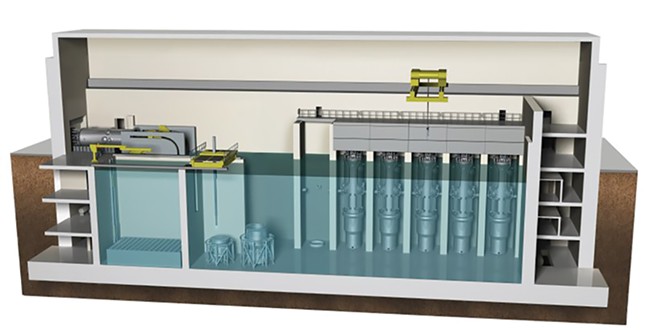
The Illinois General Assembly is one step closer to lifting the state's moratorium on the construction of new nuclear power plants. House Bill 1079, proposing to allow such construction, passed out of the Public Utilities Committee Feb. 28 on an 18-3 vote. The bill's primary sponsor is Rep. Mark Walker, D-Arlington Heights.
Nuclear power plant construction has been prohibited in Illinois since 1987 over concerns about safe disposal of nuclear waste. The current law requires that there be a demonstrable technology, or means for the disposal of high-level nuclear waste, before any construction permit for a nuclear power plant may be issued. So far, no such technology or means of disposal has been developed. According to the U.S. Environmental Protection Agency, some nuclear waste is highly radioactive and will remain so for thousands of years.
Illinois uses nuclear power to produce a higher portion of its electricity demand than any other state, at around 58%. Waste from its 11 nuclear power reactors at six power stations is currently stored temporarily on site until a permanent resting place can be found. It falls upon the Illinois Emergency Management Agency Division of Nuclear Safety to inspect Illinois' nuclear power reactors as well as inspect and escort shipments of spent nuclear fuel that moves in Illinois. IEMA has developed the Illinois Plan for Radiological Accidents to deal with potential mishaps and uses equipment so sensitive that while located in Illinois it was able to detect radiation from the 2011 Fukushima Daiichi meltdown in Japan.
Walker argued that Illinois will not be able to meet its clean energy goals without an increase in nuclear power. Testifying in favor of lifting the moratorium was Dr. Rizwan Uddin, head of the Nuclear, Plasma and Radiological Engineering Department at the University of Illinois Urbana-Champaign. Uddin said that nuclear generation is safer now than when the moratorium was enacted 35 years ago, and the prohibition puts Illinois researchers at a disadvantage, since they can't study new techniques and technologies without traveling out of state.
Lobbyist Mark Denzler of the Illinois Manufacturers Association testified that his clients need cheap energy and are enthusiastic about small modular nuclear reactors (SMNRs), some of which are small enough to be transported by rail. Rather than building a few large nuclear power plants, many smaller SMNRs could be located closer to demand centers, reducing the need for large infrastructure and lengthy high-voltage power transmission lines. He said that SMNRs would be particularly useful in the event of natural disasters or when a traditional power plant is offline.
David Kraft, director of Nuclear Energy Information Service, testified in opposition, warning that increased investment in nuclear power generation would come at the expense of renewables like wind and solar. He also testified that SMNRs produce between five and 20 times as much waste per kilowatt hour of energy as conventional nuclear plants, and the first commercial SMNR reactor isn't expected to be online until 2029 or later. As for the waste disposal problem, Kraft pointed to the train derailment in East Palestine, Ohio, as a cautionary tale. "The law is not a ban, it's a moratorium, which can be lifted as soon as adequate disposal technology has been developed," he said.
During his testimony, Kraft expressed doubts that the security of so many small plants could be assured. Because of their portability, SMNRs would likely be exported throughout the world, some of them inevitably ending up in war zones. Recent close calls at the Ukrainian nuclear power station in Zaporizhzhia show, according to Kraft, that those dangers are real and not just theoretical.
Kraft also testified that the federal government originally pledged to have a high-level nuclear waste disposal facility ready in 1997, but most recently estimated that such a facility will not be complete until 2047. Without such a facility in place and operational, there is no place for high-level nuclear waste produced in Illinois to go. Kraft told the committee that Illinois is currently home to about 11,000 tons of spent nuclear fuel, all of it stored temporarily around the plants that produce it.
Don Howard is an intern at Illinois Times while completing his master's degree in
Public Affairs Reporting at the University of Illinois Springfield. He can be reached at
[email protected] or 336.455.6966.

